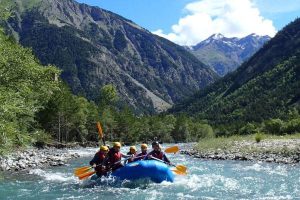
RAFTING
INSIGHT
Everything there is to know about rafting
History and evolution of a sport born from exploration
Introduction
How many of you wandered “what is rafting”? Who ever thought to run down a river on a inflatable raft? With this page we’ll shed some light on the subject!
The topics of this article
We will tell you how a tool for exploration has become part of the sport disciplines recognized by CONI and why thousands of newbies every year can afford the thrill of crossing raging rivers in complete safety!

HOME PAGE: RAFTING REPUBLIC: Rafting Aosta Valley
Etymology
Directly from Treccani, let’s see what the encyclopaedia tells us about it
The boat
RAFT
(fr. radeau; sp. balsa; ted. Floss; ingl. raft). It is commonly a set of beams and boards sturdy connected to each other even with cables and chains, capable of floating on water with a certain load. On rivers it is often customary to raft large quantities of wood to be transported by water by means of tugs.
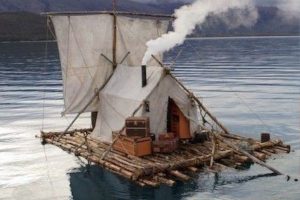
LIFE RAFT
Of particular importance are the life rafts, which can also be made up of barrels or other floats and formed in such a way as to give support to the castaways both internally and externally by means of a cable to which the castaway attaches. The regulation for the safety of merchant ships and human life at sea allows for the accommodation of life rafts in addition to a minimum total capacity of boats, when the rafts are judged to be more rapidly usable and therefore preferable to boats in an emergency.
PASSENGER TRANSPORT
The ship authorized to carry passengers on international long-sea voyages must be equipped with floating life-saving appliances in a sufficient number for 25% of the persons on board, even when the total capacity of the lifeboats is sufficient to take on board the whole of they. Rafts should not be securely fastened to the deck of the ship, but rested to float freely when the ship sinks.
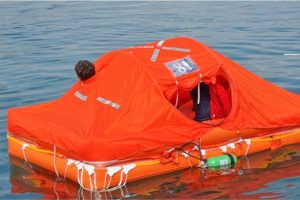
The discipline
rafting ‹ràftiṅ› s. ingl. [der. di (to) raft «to sail on a raft»], used in ital. mascular – Sports activity consisting in the descent by rubber dinghy (generally with crews of four or more people) of rivers and streams.

The story of rafting
The definition of the term therefore helps us to narrow the field. So when we talk about raftin gwe are talking about a raft that plows through a river: what does the story tell us about it?
The first rafts
Air-swollen skin
The idea of inflating something and going down a river is certainly not modern: the Babylonians already used air-filled leather skins to descend water courses. It seems that the troops of Alexander of Macedon, to cross the Ganges, had sewn together cow and horse skins and then waterproofed them with animal fat. The first example of such boats is exhibited at the British Museum in London, dating back to 880 BC. To this day, Pakistanis use rafts supported by inflated goat bellies to cross the Shigar.
The American Indians
The decisive impulse, however, comes from the American Indians. In order to move faster and fish in the richest river areas, they developed and refined the construction techniques that were then handed down to the most modern explorers who made history, such as Lewis and Clark.
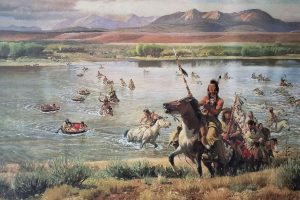
Legend or truth?
How did Polynesia populate itself? Thor Heyerdal, inspired by indigenous legends, in 1947, aboard his Kon Tiki (Inca-inspired balsa wood raft) sailed from Callao carried by the HumboltCurrent. His journey demonstrated how it was technically possible for South American populations to reach and colonize the Polynesian archipelago.
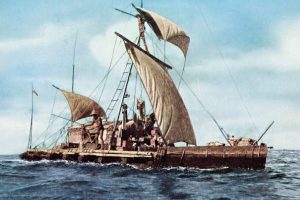
The 1800s and explorations in America
Lewis and Clark and the “Corps of Discovery” (1804-1806)
Is rafting adventure? You can bet on it. In the race to plant a flag and claim territory, then president of the young United States Thomas Jefferson encouraged an epic expedition to the Pacific Ocean. In short, the explorers Meriwether Lewis and William Clark, accompanied by a handful of adventurers, crossed North America from east to west, navigating first the Ohio River, the Mississippi and finally the Columbia(on their return), also making use of boats bought by the Native Americans.
I assure you, that was a really great story. If you want to know more: https://it.wikipedia.org/wiki/Spedizione_di_Lewis_e_Clark
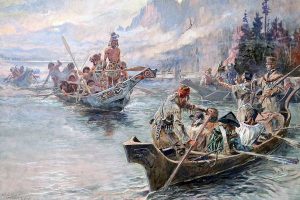
We begin to hear about “white water” (1811)
The attempt of a certain Hence “Mad River” to descend the Snake River dates back to that date. Without technical preparation or adequate material, the expedition was a fiasco. The river was only successfully navigated in 1940 by a certain Clyde Smith.
The first expedition to Colorado, the “cradle of rafting” (1869)
Still on the subject of epic feats, now it’s up to John Wesley Powell. Veteran of the Civil War in which he lost an arm Powell, at the head of 9 men and 4 boats, led the first exploratory mission on the Colorado River
Not exactly a happy picnic
Adversity abounded: an older brother with mental disorders due to long imprisonment during the Civil War, lack of food, poor John‘s calculations made badly and maps drawn worse. 3 men, needless to say, mutinied. Powell, hoping to change his mind, left one of his 4 boats ashore. Uselessly. In fact, the 3 seem to have been massacred in the meantime by the Indians of the Shivwitstribe, who had mistaken them for miners responsible for killing a woman of the tribe. Other sources say that they were killed by white settlers. To conclude with a flourish, our brave John abandoned the company just before the last rapid, at the exit of the Grand Canyon.
Success at last
He succeeded in the enterprise three years later, in 1871 and achieved his goal: a detailed cartography of the territory.
The awards
A postage stamp was dedicated to Powell’s enterprise. In 1960 he inspired a film, the original title “Ten who dared“, directed by William Beaudine
To know a bit more: https://www.mygrandcanyonpark.com/park/john-wesley-powell
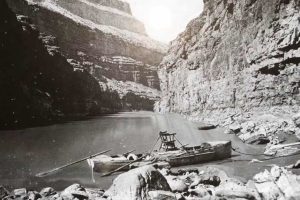
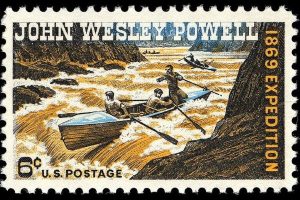
The first rubber rafts
The new technologies derive mainly from the war effort in World War II.
Some exceptions
However, the first attempt to build a rubber raft by John Fremont and Horace H. Day in the famous attempt to navigate the Snake River dates back to 1840.
Also from the mid-nineteenth century is the project of an English nautical company of a dinghy which was then tested even in the ice of the North Pole.
War use
If in 1918for the landing in Libya they used canvas boats of German invention, in 1922, the Berlin Flossbootproduced a model of pneumatic raft used even for the transport of tanks.
On the ships
The civil use of the pneumatic boat as a life raft only took place in the second half of the 1950s, after the shipwreck of the Andrea Doria demonstrated the ineffectiveness of the launches.
If you want to learn more about the raft as a boat go to the page: https://www.raftingrepublic.com/approfondimenti/imbarcazioni/raft.html
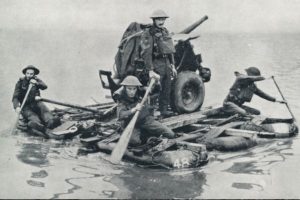
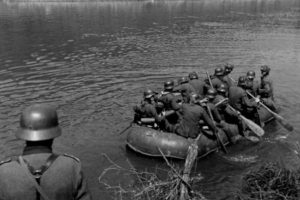
Commercial evolution
The first attempts
1940
It was only more than half a century after the famous expeditions that the emotional and playful aspect prevailed over the activity, a real prelude to the modern era of rafting. In 1940, the Snake River, in north-western Wyoming, was successfully navigated by recycling unused military rafts and, in June, the first commercial descent on the Salmon River was recorded.
The business tries to grow
Stimulated by that success, visionary J.D. Rockefeller opened the first rafting centre in 1950, at his Snake River resort in Grand Teton National Park. The first year recorded 500 passes and also in this case gigantic militaryinflatable boats, surplus of the Second World War of 8 ′ x 27 ′ (two and a half meters by eight) were used. Though slowly, the demand grew steadily. It was only in the 60s / 70s that the level of popularity grew to the point of allowing the opening of real rafting companies such as the Becker-Cooke Expedition and Slickrock Adventures
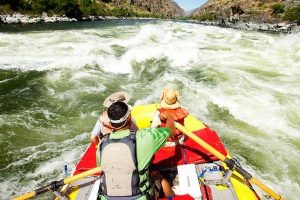
Georgie White
Georgie White, the first woman to run a shipping company on the Colorado River, should definitely be mentioned. A woman of character, she ran her company for 45 years, personally navigating the river, offering a real expedition experience in the early days.
If you want to understand how Georgina organized her trips to Colorado, take a look at this short documentary about her! Other times to say the least … https://www.youtube.com/watch?v=bHICWGEjkTs

A growing success
Made in the USA
The idea was therefore successful and, through the 70s, 80s and 90s, centers along the most suitable rivers in America flourished and the format was exported all over the world.
In Europe
Commercial rafting landed in Europe in 1982 with the AN Rafting and the Compagnie de Rafting des Arcs, French organizations still among the most important today
In Italy
In 1987, the Italian Rafting Association (A.I.Raft., Which later became the Federation) was founded in Milan, with the aim of bringing together the few enthusiasts who had not long imported the discipline into our country. Since then, the training of new guidesand the regulations aimed at improving safety in the river mainly refer to this organization
Where rafting is done in Italy
If you are interested, read our in-depth study: where you can practice rafting in Italy
